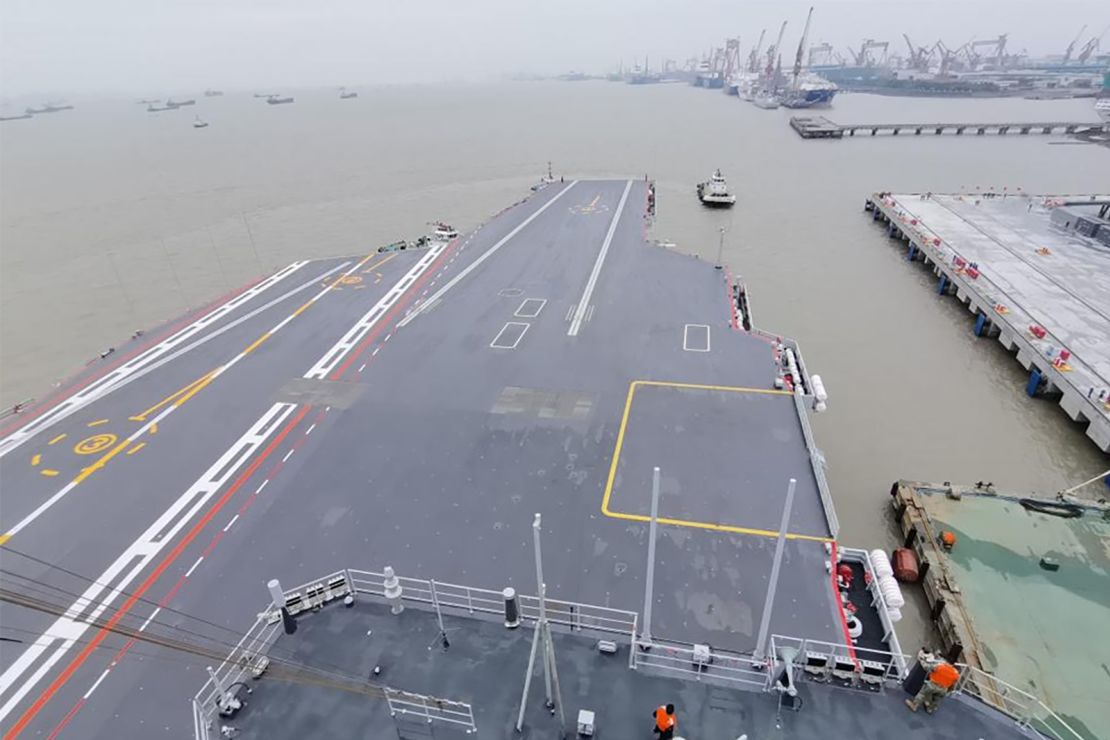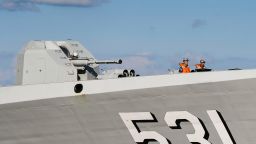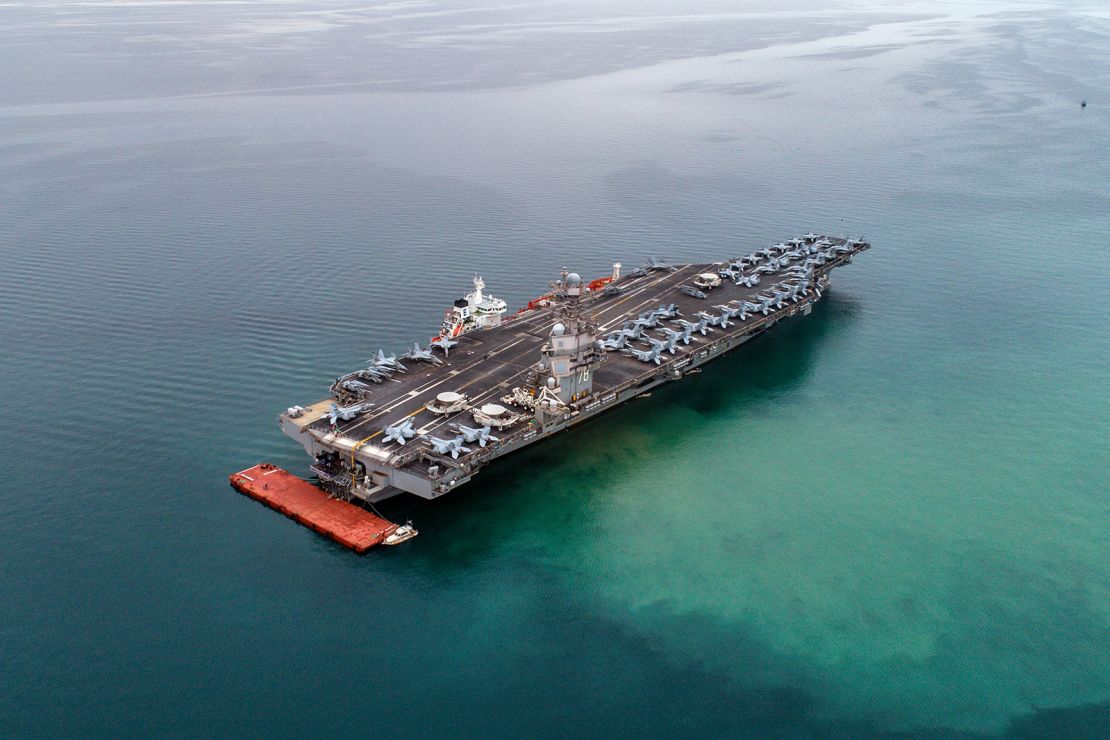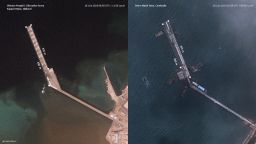China’s newest, largest and most-advanced aircraft carrier, the Fujian, took a big step to joining the world’s largest naval fleet on Wednesday as it set out from Shanghai for its first sea trials.

China’s third aircraft carrier, the Fujian, sets out for maiden sea trials from Shanghai Jiangnan Shipyard in east China’s Shanghai, May 1, 2024.
Li Yun/Xinhua
Seoul, South KoreaCNN —
The naval assessment is expected to take place in the East China Sea, about 130 kilometers (80 miles) from the Jiangnan Shipyard where the carrier has been under construction for more than six years, according to Shanghai’s Maritime Safety Administration.
“The sea trials will primarily test the reliability and stability of the aircraft carrier’s propulsion and electrical systems,” read an announcement from the state-run Xinhua news agency on Wednesday.
The warship was launched in 2022 and has “completed its mooring trials, outfitting work and equipment adjustments” working up to the latest sea trials, Xinhua said.
With a displacement of 80,000 metric tons, the Fujian dwarfs the People’s Liberation Army Navy’s (PLAN) two active carriers, the 66,000-ton Shandong and the 60,000-ton Liaoning. Only the United States Navy operates bigger aircraft carriers than Fujian.

A tugboat tows China’s third aircraft carrier, the Fujian, away from a dock in east China’s Shanghai on May 1, 2024.
Li Tang/Xinhua
“The Fujian’s sea trials represent an important milestone for the PLAN, marking its entry into the small club of top-class carrier aviation-capable navies,” said John Bradford, a Council on Foreign Relations International Affairs fellow.
The Fujian’s key feature is an electromagnetic catapult system that will enable it to launch larger and heavier aircraft than the Shandong and Liaoning, which use a ski-jump style launch method.
Analysts say the Fujian’s ability to launch larger warplanes carrying higher munitions loads to farther distances will give the carrier a greater combat range than its predecessors in the Chinese fleet, providing the PLAN with so-called “blue-water” capabilities.
“These sea trials mark the first major step in China’s developing the capacity to project sea-based air power into deep ocean areas,” said Carl Schuster, a former US Navy captain and former director of operations at the US Pacific Command’s Joint Intelligence Center.
Comparison to US carriers
The electromagnetic catapult system puts the Fujian on par with the US Navy’s newest carrier, the USS Gerald R Ford, the only active carrier in the world with an electromagnetic catapult system.
The US Navy’s 10 older carriers, the Nimitz class, rely on steam-powered catapults to launch aircraft.

All the US carriers, however, will retain two key advantages over the Fujian: power and size.
The US carriers are nuclear powered, giving them the ability to remain at sea for as long as crew provisions last, while the Fujian is powered by conventional fuel, meaning it must either make a port call or be met by a tanker at sea to refuel.
As for the US Navy’s size advantage over the Fujian, the Ford displaces 100,000 tons and the 10 Nimitz-class ships 87,000 metric tons.
The larger US ships can take on more aircraft, around 75 compared to an expected complement of 60 on the Fujian, according to estimates by the Center for Strategic and International Studies (CSIS).
Analysts have also noted that the US carriers have more catapults, a larger airway and more elevators to allow for quicker deployment of aircraft from the hangar deck below.
The US carriers “remain in an echelon of their own,” Bradford said.

The American aircraft carrier USS Gerald R. Ford is seen from the air anchored in Italy in the Gulf of Trieste on September 18, 2023.
Andrej Tarfila/SOPA Images/LightRocket/Getty Images
Schuster said the current round of sea trials for Fujian are expected to last three to six days and would not include flight operations.
“Radars and communications equipment will get some testing, but the first sea trials always focus on hull integrity, propulsion and engineering since problems there prevent everything else from working well,” Schuster said.
In total, analysts expect the Fujian’s sea trials to take at least a year, with its commissioning likely to come next year or in 2026.
A story on the website of the Chinese Defense Ministry in January noted the Liaoning underwent 10 sea trials and the Shandong nine before entering service.

When it joins the PLAN fleet, the Fujian will become the icon of what is now the world’s largest naval force,with more than 340 warships and counting as Chinese shipyards turn out new warships at a frenetic pace.
“It will be the most visible symbol of China’s growing naval power,” said Brian Hart, a fellow with the China Power Project at the CSIS.
Meanwhile, the announcement of a fourth carrier for the Chinese fleet could come soon, PLAN political commissar Yuan Huazhi said in March, according to a report in the state-run Global Times.
When that announcement is made, the answer as to whether China will have a nuclear-powered carrier will be answered, the report said.
The US Navy already has three new Ford-class carriers under construction, the future John F Kennedy, Enterprise and Doris Miller.